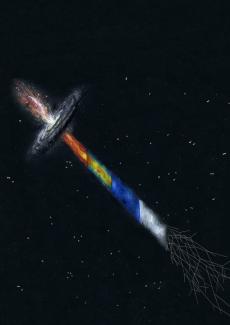
Extreme Blazars: when particle acceleration reaches new heights
Blazars are intense sources of light visible from Earth through powerful telescopes. They are located at cosmological distances and, for the time being, are still partly mysterious. Jonathan Biteau, a researcher at the Irene Joliot-Curie Laboratory (IJC Lab - Paris-Saclay University, CNRS), and other European astrophysicists recently conducted the first inventory of the most energetic of them all: extreme blazars. To gain a better understanding of these prodigious particle accelerators.
Probing ever more deeply into the structure of the Universe, perfecting the laws of fundamental physics or plasma physics... These are all ambitious goals that astrophysicists relentlessly pursue through their work and observations. And in the jungle of extragalactic objects they are interested in, blazars stand out as fascinating subjects of study. Located a few billion light years from Earth, these faraway objects belong to the large family of galaxies with an active nucleus. In the centre of them, a supermassive black hole - several billion times the mass of the Sun - sinks some of the matter concentrated in the surrounding accretion disc, while another part escapes as an ultra-bright jet of particles.
"The plasma that gushes from the active core radiates photons of every wavelength, from radio waves to gamma radiation," says Jonathan Biteau, astrophysicist at the Irène Joliot-Curie Laboratory (IJC Lab - Paris-Saclay University, CNRS). "We also find electrons and probably their antiparticles, the positrons." Would there also be other heavier particles, such as protons or nuclei? This is what specialists from these sources are actively looking for. "Studying blazars helps to answer several questions: How do the different active galactic nuclei behave? How do their observational properties differ? How do they emit their bright jet? What is the link between the jet and the black hole, and between the black hole and the accretion disk? How are particles accelerated within the jet and how do they radiate? " suggests Jonathan Biteau. The questions are extremely varied, but researchers are not moving in the dark.
Already in the 1950s, the physicist Enrico Fermi proposed several mechanisms explaining the acceleration of particles within sources, which involved magnetic fields on which the particles bounced. As they bounce, these particles acquire more energy and radiate more energy. "Today, we are familiar with a number of physical mechanisms that occur in very high-energy sources and that meet these conditions, such as shock wave or shear wave acceleration, turbulence and magnetic reconnection," explains Jonathan Biteau.
Unveiling the extreme acceleration of particles
The researcher is particularly interested in a very small fraction of blazars (≤1%): extreme blazars, “those whose emission is particularly intense at high energies, especially beyond the teraelectron-volt (TeV, i.e. 1012 eV)." These objects radiate in the gamma band - the most energetic electromagnetic radiation - and currently only about twenty (24) have been observed. "Since the beginning of the 2000s and the major Cherenkov experiments looking for very high energy gamma emissions - namely H.E.S.S., MAGIC and VERITAS - the question has been whether or not these extreme blazars represent the tip of the iceberg, whether they have the same mode of operation as other blazars or really differ from them," comments Jonathan Biteau.
In collaboration with other European colleagues (French, German and Italian), he recently conducted a survey on them, the first on this type of source. The researchers analysed the observational properties of the 24 extreme blazars already observed, compared them to those expected, and deduced a rather complex table. While some objects seem to belong to the dominant pattern, others, those of higher energy, are moving away from it. "In recent years, it has become apparent that the properties of extreme blazars are more difficult to explain. For classical blazars, the emission of photons up to X-ray energies is explained by synchrotron radiation from electrons and positrons: their movement in the magnetic field causes them to emit light. These electrons and positrons collide with the emitted synchrotron photons by the Compton effect, resulting in a double hump spectrum. But for extreme blazars, this simplistic model is beginning to show its limitations. It is particularly difficult to explain why there is a peak beyond TeV and why the emission evolves so drastically as a function of energy," notes Jonathan Biteau. Several alternative scenarios are trying to provide explanations, "but as only 24 of these objects have been identified so far, it is difficult to agree on one of them," adds Biteau.
New facilities to densify observations
With the advent of new generations of telescopes in the coming years, scientists hope to increase the amount of observations of these blazars. "Today we are facing a sensitivity limit on the instruments: we only see the brightest extreme blazars. To see more of them, we need to increase sensitivity to lower intensities and get a real population of extreme blazars," admits Jonathan Biteau. Currently, the maximum energy measured using gamma photons from an extreme blazar is 20 TeV. "But we don't know if all extreme blazars can reach such energies, or even go beyond, up to 100 TeV, who knows!" This is what the future Cherenkov Telescope Array (CTA) observatory, currently under construction in La Palma (Canary Islands) and Paranal in Chile, will try to answer, with the first observations expected in 2022.
"Thanks to our recent work, we now have a coherent and unified view of all the extreme blazars that have already been observed. A specific classification is set in stone. This provides a very good basis for further research on this type of object," concludes Jonathan Biteau.
J Biteau, J., Prandini, E., Costamante, L. et al. Progress in unveiling extreme particle acceleration in persistent astrophysical jets. Nature Astronomy (2020). https://doi.org/10.1038/s41550-019-0988-4.
Crédits de l'illustration : E. Ampezzi, B. Del Piccolo, C. Schiavo (Liceo Artistico Modigliani, Padova) and E. Prandini (University of Padova).

